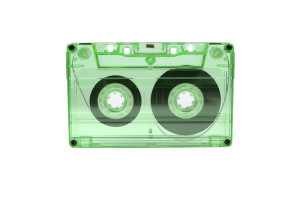
Blogging is all the rage, but podcasting is raging faster. With series like the new mega hit “Serial“, podcasts are becoming more and more mainstream every day. Every major player is embracing on-demand. Netflix, the new Amazon Fire TV Stick, Apple TV and even stand-alone televisions now stream content without an antenna or cable service. Traditional networks are offering subscription services with a monthly fee to get their free broadcast content on-demand. You do need an internet connection, but cars can use mobile wireless to achieve the same thing.
 Enter The Podcast
Enter The Podcast
Podcasting is not new, but it’s becoming new (meaning mainstream). It all started with the release of the iPod in 2001. Then, in 2005, Apple released the iTunes app with podcasting integration. It truly exploded when the first iPhone surfaced in June of 2007. In 2014, mainstream media and marketers started to take the podcast world by storm. Now, in 2015, the New Media Expo (NMX) has integrated with the National Association of Broadcasters (NAB) convention to produce a convergence of new and traditional media for the first time.
Types of Podcasts
Podcasts come in many forms with various frequencies, qualities and purposes. The easy and free way to do this is to host a BlogTalkRadio show that can air as often as they will allow for free. Generally, these tend to be phone calls only with low quality audio and production value. Some are better produced and managed (uploaded audio vs recorded via their system), but most sound just like phone calls.
High quality podcasts are professional audio productions using quality art, mics and audio editing software, and some are even produced in professional recording studios. As an audio geek, my productions include compressors, noise gates, eq’s and vocal enhancers with lots of technology. This is the current trend for high quality, highly produced and targeted programming. Here are a few examples of the types of podcast programming available:
- Entertainment – Shows like news, comedy or pure entertainment fit this category. They are slick with high production value and focus on quality if they want to attract sponsors.
- Educational – These are used to promote a brand or a product through training and/or interviews about concepts or how to’s. These come in both audio and video flavors as well.
- Informational – These can be dialogues or interviews. They range from trending topics to specific business, political or informational concepts, and tend to be more like standard talk radio.
Lengths of Podcasts
The average TV show is 22 minutes long leaving 8 minutes for commercials (that means over ¼ of the time is for sponsors). Podcasts take a different approach, with these being the most common types:
- Short Form – These are generally news or tip type programs, based on something like the The Osgood File or CBS Sports Minute. They are short 1-3 minute digests that get the point across, and are quick, repetitive and best for shows aired once or multiple times per day.
- Mini Form – These are usually 5-15 minutes, with the most successful lasting 9-10 minutes. They can be done daily, but most typically are 2-3 times per week. These are generally educational, inspirational or informational.
- Long Form – These are full-length 30-60 minute programs. More often than not, they are entertainment shows or informational interviews. Unless part of a larger consortium, these shows are typically done weekly.

Creating a podcast is a great way to spread your message and share your vision; however, it is much more time consuming than writing a blog and technically more challenging to do it right! I am 27 episodes into my podcast, and just starting to get my “Stella” groove, but like anything in business, it will grow, evolve or die (die is NOT in my vocabulary). Plus, I am having so much fun going back to my audio production roots; I can’t wait to see how I can improve it!
I would love to hear your comments and feedback, and please contact me if you have a topic you would like to see me cover on my podcast that could help you!
This article was syndicated from Business 2 Community: Check 1, 2, 3 – The Business of Podcasting
More Sales & Marketing articles from Business 2 Community:


 Enter The Podcast
Enter The Podcast

